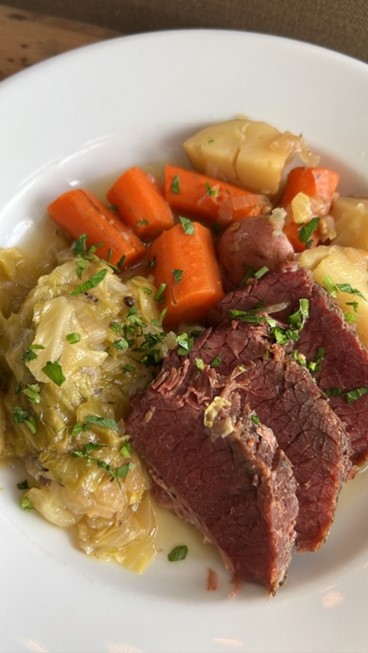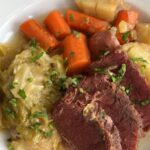
This post is sponsored by Beef. It’s What’s For Dinner. on behalf of the Beef Checkoff. All opinions are my own.
Every year as St. Patrick’s Day approaches my husband checks in to make sure Corned Beef and cabbage is on the menu. Yes, 22 years later it’s still on the menu! During the first year of our marriage, I had no idea what he was talking about and had to call my mother-in-law for details and instructions.
One year, about a decade after our wedding, I completely forgot to add Corned Beef and Cabbage to our St. Patrick’s Day menu. There was a palpable disappointment on my husband’s face when he realized we weren’t having our typical March 17 dinner. If you know him, you know his perpetual smile. So, I haven’t missed a St. Paddy’s Day Corned Beef and Cabbage dinner since. And honestly, it’s become one of my favorite springtime traditions since it’s a dinner that incorporates all my favorite things: it’s one pot, hands-off, and a fan favorite in my family.

Stove Top, Pressure Cooker or Slow Cooker!
When I first started making Corned Beef, I cooked it low and slow on the stovetop. Since then, I’ve made it in both the slow cooker and more recently in the pressure cooker (my favorite method to date!). All three cooking methods produce a delicious result. I include instructions for all of them in the recipe below.
Purchase store-bought Corned Beef that is pre-brined and ready to cook, they are readily available at grocery store meat markets starting at the end of February. I typically buy two and then stash one in the freezer for a later date. We’ll make it on a Sunday in early May when my kids are busy studying for finals – the shaved meat is delicious on Corned Beef sliders with thousand island dressing and cole slaw. I also love leftover Corned Beef chopped up and warmed in a skillet as breakfast hash. Or make vegetable beef soup with the leftover Corned Beef, vegetables, and beef stock.
Recipe Research
I’ve cured my own Brisket for Corned Beef and I’ll give you my two cents: Buy it pre-brined! The trade-off in refrigerator space and the time investment is well worth it. If you do want to brine your own Brisket for Corned Beef, you’ll need to purchase pink sodium nitrate, or brining salt. “Pink salt” gives corned beef it’s typical pink color and briny flavor, but don’t confuse it with Himalayan pink mineral salt. Sodium nitrate is dyed pink so you know it’s not regular table salt.
In the name of research, I recently tried to brine Corned Beef without sodium nitrate. It’s not something typically stocked in most home pantries, and I wanted a simplified Corned Beef recipe without ingredients that are hard to track down. While the finished flavor of the Brisket was delicious, it didn’t turn out as briny and flavorful as Corned Beef. The Corned Beef just didn’t taste like Corned Beef! It was more like a marinated Brisket, and without sodium nitrate, it turned completely brown when cooked. Plus, I know you guys prefer a shortcut when possible. If there’s a way to avoid starting a recipe 5 to 7 days in advance, I’m sure you’re in. Faster and fewer ingredients seem to be our collective mojo these days.

That’s where the pressure cooker earns extra bonus points. You’ll start with store-bought Corned Beef, which is pre-brined and packaged with pickling spices, and most importantly, ready to use. Just add onion, water, cabbage, potatoes, and carrots and an easy dinner will be waiting for you in no time. The pressure cooker creates fall-apart and super tender Corned Beef in about an hour and a half total, and your whole house will smell like you’ve been slow braising Corned Beef all day long. Soda bread, and green beer, are optional!

WHAT IS CORNED BEEF?
Corned Beef is Brisket that is brined, usually in a mixture of salt, sugar, pickling spices, and sodium nitrate. The pickling spice mixture may be made with cloves, mustard seeds, bay leaves, peppercorns, and coriander seeds.
HOW DO I BRINE MY OWN CORNED BEEF?
It’s not complicated, it just means planning several days in advance of St. Patrick’s Day. You can make your own pickling spice mix or use store-bought pickling spices. Add 3 tablespoons of the pickling spice to a pot filled with about a gallon of water, 2 cups kosher salt, 1 tablespoon plus 2 teaspoons pink curing salt (not the same as Himalayan salt), and ½ cup brown sugar (dark or light both work) and bring to a simmer. Stir to dissolve the salt and sugar. After the mixture is combined, cool completely. Then add the Brisket, cover, and refrigerate for 5 to 6 days, turning the meat every day. The brined meat will be removed from this liquid before it’s cooked; be sure to discard the brined liquid.
HOW CAN I USE LEFTOVER CORNED BEEF?
Corned Beef sandwiches! Use rye bread, small sandwich or ciabatta rolls and top with thousand island dressing, grainy mustard or prepared horseradish, cole slaw and Swiss cheese. Or chop up leftover Corned Beef and cook it in a skillet as a breakfast hash. You can also use leftover Corned Beef in vegetable beef soup.
HOW SHOULD I SERVE CORNED BEEF?
In my family, we serve sliced Corned Beef served with boiled cabbage, potatoes, and carrots and drizzled with a little red wine vinegar. If you like, add a dollop of grainy mustard or prepared horseradish.

Corned Beef with Cabbage, Potatoes and Carrots
Ingredients
- 3 lb Corned Beef
- 1 tbsp pickling spice
- 1 onion yellow or white, sliced in half moons
- 3-6 cups water depending on cooking method
- 4-5 carrots cut in 2-inch pieces
- 6 small unpeeled baby potatoes red or yellow, quartered
- 1/2 a cabbage cut in wedges, or 1 whole small cabbage, cut in wedges
- Red wine vinegar and mustard for serving
- Fresh parsley minced, for optional garnish
Instructions
Pressure Cooker Instructions:
- Add the sliced onion and 3 cups water to the pressure cooker insert. Cut the Corned Beef in half and place it on top of the onions. Seal the lid and make sure the valve is in the “sealing” position. Cook for 70 minutes on Manual/High. (Note: That cooking time is for a 3-pound Corned Beef, if you're cooking a half portion, reduce the cooking time to 50 minutes.)
- Once the pressure cooker beeps and the time is up, manually release the steam. To do that, I place a kitchen towel on top of the valve and carefully turn the valve with tongs, being careful of the steam that releases. When the pressure has released, the pin on the lid of the pressure cooker will pop up and you can easily turn and open the lid.
- Add the potatoes, cabbage and carrots and reseal the lid. Make sure the valve is set to “sealing.” Set the time to 10 minutes on Manual/High.
- Once finished cooking, manually release the pressure by rotating the valve with tongs to carefully release the steam. Open the lid and check the internal temperature of the Corned Beef, it should be at least 160 degrees F measured on an instant read meat thermometer.
Slow Cooker Instructions:
- In your slow cooker insert, add the sliced onion and 4 cups water. If the Corned Beef doesn’t fit in one flat layer, cut it into two pieces so it will lay flat in the slow cooker. Place the beef on top of the onions along with the pickling spices. Add the slow cooker lid and set to HIGH for 5 hours or LOW for 8 hours. After 2 hours of cooking time, add the cabbage, potatoes and carrots. Replace the lid and continue to cook the Corned Beef and vegetables until fork-tender and the internal temperature reaches at least 160 degrees F.
Stove Top Instructions:
- In a large Dutch oven or large soup pot, add the sliced onion and the Corned Beef. Add enough water to cover the Corned Beef by an inch, about 6 cups.
- Bring the onion, water and beef to a simmer, then cover and keep the heat on low. Keep simmering the meat in the liquid, covered, until fork tender, about 3-4 hours. The internal temperature of the meat should reach 160 degrees F.
- Remove the meat from the pot and place on a large plate or platter; cover with foil. Transfer the meat to a pre-heated 200-degree oven to stay warm.
- Add the vegetables to the pot. If there isn’t enough liquid because some of it has evaporated during the cooking process, add another 1-2 cups of water, or enough to come up to the top of the vegetables. Raise the heat to medium and cook the vegetables, covered, until fork tender. About 25-30 minutes.
- The last 5-10 minutes of cooking the vegetables, add the meat and any accumulated juices back to the pot. Stir to combine.

Leave a Reply